In the realm of interior design, where every space tells a story and every element holds meaning, the fusion of cultures and design philosophies often leads to the creation of something truly extraordinary. One such captivating synthesis is Japandi fusion – a seamless blend of Japanese minimalism and Scandinavian simplicity that transcends boundaries and captivates the senses. As the renowned architect and designer, Tadao Ando, once remarked, “I believe that architecture is a pragmatic art. To become art, it must be built on a foundation of necessity.” Let us delve deeper into the essence of Japandi fusion in interior design in London and discover how it embodies the principles of simplicity, functionality, and beauty in interior design.
Unveiling the Evolution of Japandi Fusion in Interiors
At its core, Japandi fusion represents the harmonious integration of two rich design traditions – the elegant simplicity of Scandinavian design and the tranquil aesthetics of Japanese culture. Initially defined by clean lines, natural materials, and a balance of form and function, Japandi design has undergone a remarkable evolution over time. From its inception rooted in Japanese minimalism and Scandinavian simplicity to its contemporary interpretations, Japandi design has embraced diverse cultural influences and innovative design concepts. Today, it encompasses a broader spectrum of styles while remaining true to its foundational principles of simplicity, craftsmanship, and reverence for nature. As sustainability and technological advancements shape the landscape of modern living, Japandi design continues to adapt, offering versatile solutions that seamlessly blend tradition with innovation. This ongoing evolution underscores the enduring relevance and appeal of Japandi fusion as a timeless expression of harmonious living.
Key Principles of Japandi Design
Japandi design principles are deeply rooted in a philosophy that celebrates simplicity, functionality, and the harmonious integration of Eastern and Western aesthetics. At its core, Japandi interiors embody the principle of simplicity in form and function, echoing the famous words of architect Ludwig Mies van der Rohe, “Less is more.” This ethos is palpable in the clean lines, uncluttered spaces, and
profound sense of balance and tranquility that define Japandi spaces. For instance, minimalist furniture pieces like sleek wooden tables and low-profile seating contribute to the overall minimalist aesthetic, fostering a serene ambiance that invites relaxation and introspection.
Natural Materials and Textures
Natural materials and textures play a pivotal role in shaping the character of Japandi design, drawing inspiration from the timeless beauty of the natural world. Wood, bamboo, stone, and linen take center stage, infusing spaces with warmth, texture, and a palpable connection to nature. Examples abound, from the use of reclaimed wood for furniture to bamboo blinds for window treatments and stone countertops in the kitchen. Each element contributes to the organic feel of the space, inviting occupants to immerse themselves in a tranquil haven where simplicity meets sophistication.
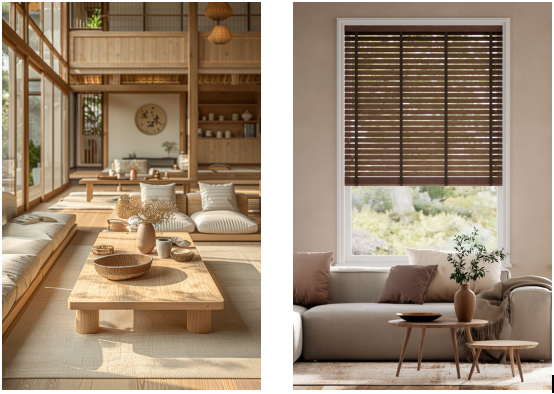
Subdued Color Palette
In addition to natural materials, the subdued color palette characteristic of Japandi design sets the stage for a serene and harmonious ambiance. Soft neutrals such as
whites, grays, and earthy tones dominate, creating a tranquil backdrop that allows key design elements to shine while promoting a sense of tranquility and balance. Picture a living room adorned with a neutral-colored sofa paired with earth-toned
throw pillows and a soft gray rug—a perfect embodiment of the calming atmosphere synonymous with Japandi interiors.
Attention to Detail
Attention to detail serves as a hallmark of Japandi interiors, where every element is carefully chosen with intention and purpose. From meticulously curated furnishings to thoughtfully selected décor accents, each component contributes to the overall
sense of craftsmanship and authenticity. Think of handmade ceramics proudly displayed on open shelves, woven textiles adorning accent chairs, and sculptural lighting fixtures adding visual interest to the space. These nuanced details infuse the interior with depth and character, elevating it to a realm of timeless elegance.
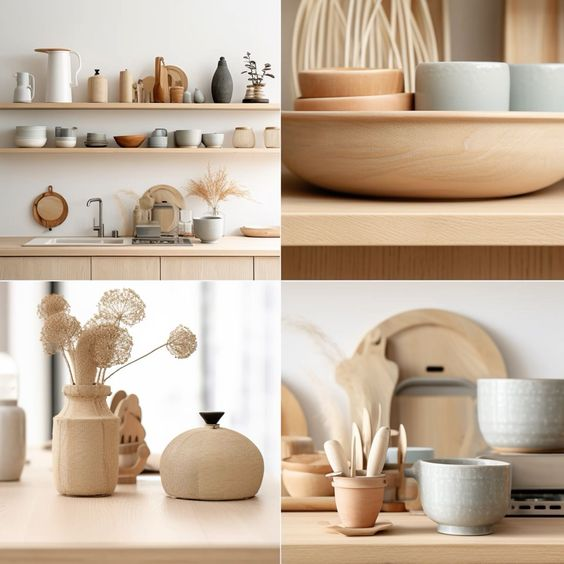
Harmony of Blending Eastern Serenity with Western Coziness
Japandi design embodies a harmonious fusion of Eastern serenity and Western cosiness, celebrating cultural exchange and mutual respect. This symbiosis is
evident in the seamless integration of Japanese and Scandinavian design elements, such as the use of traditional Japanese shoji screens alongside Scandinavian-inspired furniture pieces. By skillfully blending elements from both cultures, Japandi design creates spaces that feel simultaneously timeless and contemporary—a tranquil retreat from the complexities of modern life where simplicity reigns supreme.
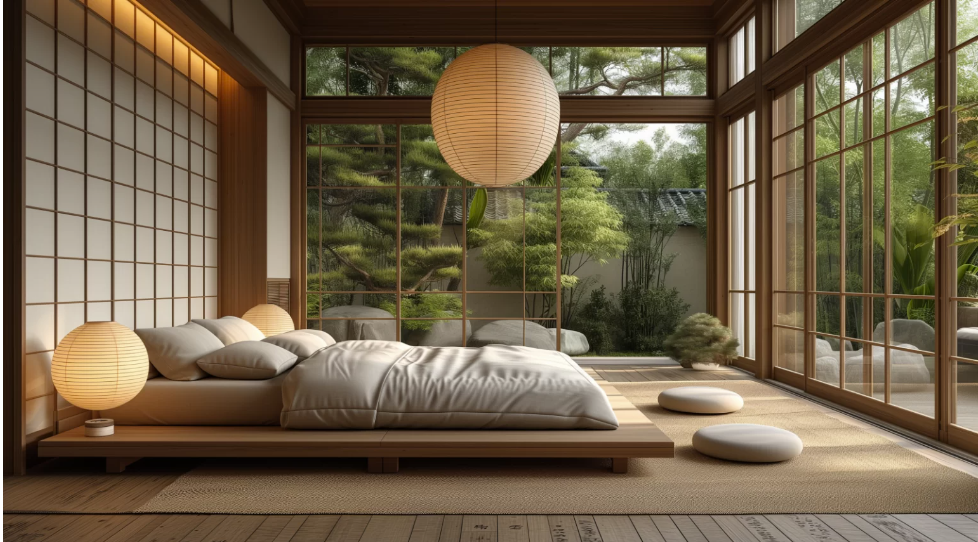
Bringing Japandi Fusion Into Your Home
Transforming your living space into a sanctuary of timeless elegance and tranquility begins with embracing the essence of Japandi fusion. Drawing inspiration from the understated elegance of Scandinavian design and the timeless tranquility of Japanese aesthetics, Japandi fusion offers a harmonious blend of minimalism, functionality, and natural beauty. By incorporating key elements of Japandi design into your home, you can create a space that exudes serenity, sophistication, and a sense of balance. “Let’s delve into ways you can infuse your living space with the essence of Japandi fusion, elevating your home with its timeless allure.
Minimalist Furniture
Begin your Japandi-inspired transformation by choosing furniture that epitomises simplicity and functionality. Opt for pieces with clean lines, natural finishes, and a timeless appeal. Low-profile seating, such as sleek sofas and armchairs, not only provide comfort but also contribute to a minimalist aesthetic. Pair these with wooden tables featuring elegant designs and multi functional storage solutions that maximise space while maintaining a sense of orderliness.
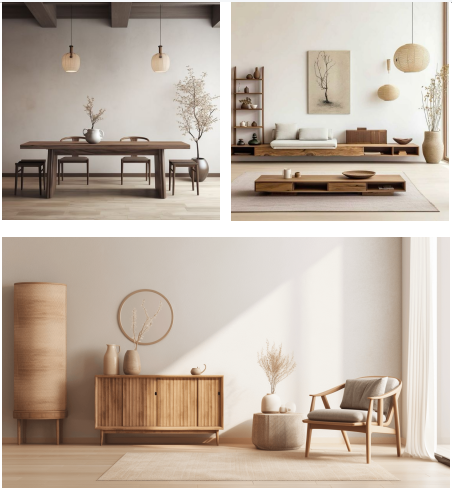
For example, a low-slung sofa upholstered in neutral fabric, paired with a minimalist coffee table crafted from light-toned wood, can serve as the focal point of your living room, embodying the essence of Japandi design.
Embracing Natural Materials
Infuse your living space with the warmth and texture of natural materials to create a serene and inviting atmosphere. Incorporate light-toned woods, such as oak or ash, for flooring, furniture, and decor accents. Rattan and bamboo can be used for seating, lighting fixtures, and decorative elements, adding organic texture and visual interest. Additionally, consider incorporating stone, such as marble or granite, for countertops, accent walls, or statement pieces, adding a touch of timeless elegance to your home. For instance, a dining table crafted from reclaimed wood, paired with rattan dining chairs and stone pendant lights, can create a cohesive and inviting dining area that embodies the essence of Japandi fusion.
Serene Color Palette
Maintain a sense of harmony and tranquility by sticking to a neutral color palette with subtle accents inspired by nature. Opt for soft whites, warm grays, and earthy tones to create a serene backdrop throughout your home. Introduce subtle pops of color with muted hues such as sage green, soft blue, or blush pink, drawing inspiration from natural elements like foliage, sky, and earth. For example, a bedroom adorned with crisp white bedding, gray walls, and accents of soft green in the form of throw pillows or artwork can evoke a sense of calm and relaxation, perfectly complementing the Japandi aesthetic.


Decorative Accents
Focus on quality over quantity when selecting decorative accents, incorporating Japanese-inspired elements that exude elegance and tranquility. Choose pottery and ceramics with organic shapes and earthy tones to add artisanal charm to your space. Introduce bonsai trees or potted plants to bring a touch of nature indoors, enhancing the overall sense of serenity. Ikebana arrangements, characterised by minimalistic floral compositions, can serve as focal points on tabletops or mantels, adding grace and simplicity to your home. For instance, a collection of handmade ceramic vases displayed on open shelves, accompanied by a bonsai tree and a minimalist ikebana arrangement, can elevate the aesthetic of your living room while staying true to the principles of Japandi design.
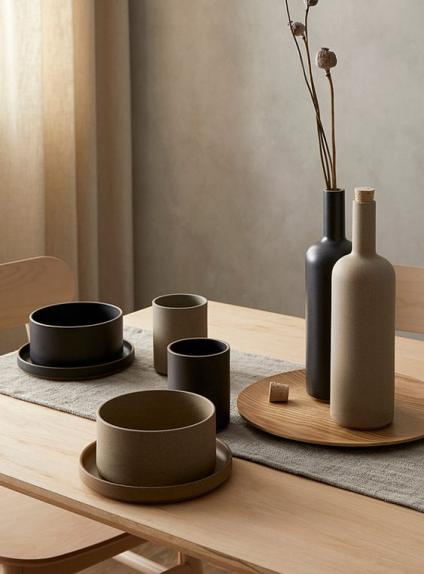


Crafting Ambient Lighting
Illuminate your home with soft, diffused lighting to create a warm and inviting ambiance that complements the Japandi aesthetic. Incorporate paper lanterns, pendant lights, and floor lamps with simple yet elegant designs to cast a gentle glow throughout your space. Consider installing dimmer switches or smart lighting systems to adjust the intensity of light according to your mood and activities. For example, a paper lantern suspended above a dining table, paired with pendant lights and floor lamps strategically placed around the room, can create a soft and welcoming atmosphere ideal for intimate gatherings or quiet evenings at home.
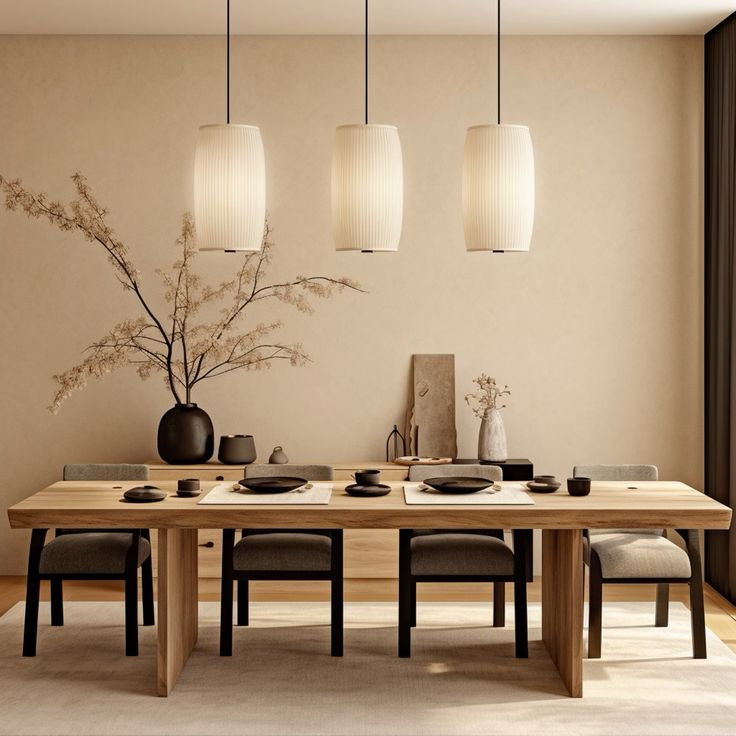
Japandi fusion offers a timeless approach to interior design that celebrates the beauty of simplicity, the warmth of natural materials, and the harmony of cultural exchange. As Tadao Ando once said, “I believe that architecture is a medium of light and space and that the experience of space is essential to the art of architecture.” Embrace the essence of Japandi fusion with Oraanj Interior Design and discover the art of living in harmony with nature and culture.

